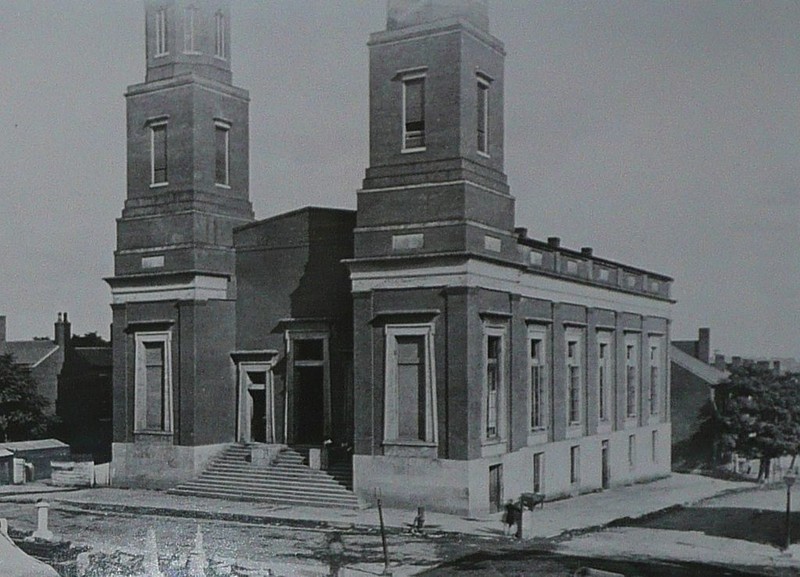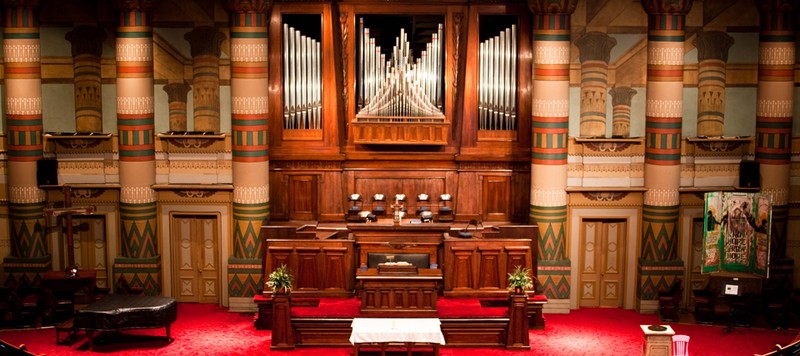Downtown Presbyterian Church
Introduction
Text-to-speech Audio
Constructed in 1848, this historic Nashville church dates back to the earliest years of the city. and replaced two previous structures that were built in 1814 and 1832. That first church structure was built here in 1814 and was destroyed by a fire in 1832. A second sanctuary was constructed the same year and the third (and present) sanctuary was constructed after another fire in 1848 destroyed the second church. The current church was designed by William Strickland, who also designed the Tennessee State Capital and who has been called by the National Park Service's National Historic Landmarks program "one of the foremost architects in the United States." The church was partially unfinished during the Civil War when it was used by occupying Union forces as a hospital. The columns were put in place in 1871, and much of the other finishing details were completed in the remaining decades of the 19th century. The church was known as First Presbyterian until 1955 when the name was changed to "Downtown" after the First Presbyterian congregation moved to a more suburban location. It is affectionately known as the "Karnak on the Cumberland."
Images
Downtown Presbyterian Church

This photo shows the building as it likely appeared in the Civil War, when it was used by the Union army as a hospital.

The church is one of the few examples of Egyptian Revival architecture in the United States, and may be the best surviving example of this style being incorporated into the interior of a church edifice.

Backstory and Context
Text-to-speech Audio
In Nashville in 1801, Scottish pastor William Hume founded a congregation that was later joined by the local Presbyterians. The First Presbyterian Church congregation was thought to have been legally established by the Rev. Gideon Blackburn on November 14, 1814, though the exact date is disputed. The Rev. Blackburn's entire congregation consisted of seven people -- only one of whom was a man. The church is located at the corner of Fifth and Church Streets.
In 1915, following his victory at the Battle of New Orleans, Andrew Jackson was presented by the State of Tennessee with a ceremonial sword on the steps of the church. The building was destroyed by a fire in 1832, but a second building was constructed on the same site. This second church hosted the inauguration of James K. Polk (the future president) as governor of Tennessee in 1839, but that building, too, burned down in 1848.
At that time, the distinguished Philadelphia-based architect William Strickland was in Tennessee, designing and supervising construction of the State Capitol. The congregation hired Strickland to design their new church. Construction began in 1849 and ended in 1851, when it was dedicated on Easter Sunday. At the time it was built, the congregation had only about 350 members. However, they had Strickland design a space to seat over 1000 people and thus ran out of money to fully finish the building. According to the National Historic Landmarks program, the church was "Strickland's largest and only full Egyptian temple." Exterior elements that identify the style as Egyptian are the cavetto cornice, the lotus-bud capitals, and the designs of the sun disk and cobra. It was nicknamed the "Karnak on the Cumberland," because Strickland had modeled it on the temple to Amon-Ra at Karnak.
In 1862, during the Civil War, the church was appropriated by the occupying Federal forces and converted into a military hospital. In 1865, it was released by the Union and given back to the congregation. Receiving reparations from the US government, they preceded to try to complete the construction left unfinished in 1851. They added the columns and the entablature in 1871 and redesigned and refurbished the interior in 1880.
In the 20th Century, the church served as a shelter for flood victims in 1927 and 1937, as well as for thousands of US servicemen during the Second World War who were on leave in Nashville. Although the First Presbyterian congregation decided to move to a suburban Nashville location in 1954, the old church was spared and its name changed to "Downtown Presbyterian Church." It still serves the needs of people in the area.
A celebrated feature of the church is its pipe organ. This was installed in 1913, and was renovated in 1972 and again in 2008. The church holds annual organ recitals that attract players and listeners from great distances.
In 1915, following his victory at the Battle of New Orleans, Andrew Jackson was presented by the State of Tennessee with a ceremonial sword on the steps of the church. The building was destroyed by a fire in 1832, but a second building was constructed on the same site. This second church hosted the inauguration of James K. Polk (the future president) as governor of Tennessee in 1839, but that building, too, burned down in 1848.
At that time, the distinguished Philadelphia-based architect William Strickland was in Tennessee, designing and supervising construction of the State Capitol. The congregation hired Strickland to design their new church. Construction began in 1849 and ended in 1851, when it was dedicated on Easter Sunday. At the time it was built, the congregation had only about 350 members. However, they had Strickland design a space to seat over 1000 people and thus ran out of money to fully finish the building. According to the National Historic Landmarks program, the church was "Strickland's largest and only full Egyptian temple." Exterior elements that identify the style as Egyptian are the cavetto cornice, the lotus-bud capitals, and the designs of the sun disk and cobra. It was nicknamed the "Karnak on the Cumberland," because Strickland had modeled it on the temple to Amon-Ra at Karnak.
In 1862, during the Civil War, the church was appropriated by the occupying Federal forces and converted into a military hospital. In 1865, it was released by the Union and given back to the congregation. Receiving reparations from the US government, they preceded to try to complete the construction left unfinished in 1851. They added the columns and the entablature in 1871 and redesigned and refurbished the interior in 1880.
In the 20th Century, the church served as a shelter for flood victims in 1927 and 1937, as well as for thousands of US servicemen during the Second World War who were on leave in Nashville. Although the First Presbyterian congregation decided to move to a suburban Nashville location in 1954, the old church was spared and its name changed to "Downtown Presbyterian Church." It still serves the needs of people in the area.
A celebrated feature of the church is its pipe organ. This was installed in 1913, and was renovated in 1972 and again in 2008. The church holds annual organ recitals that attract players and listeners from great distances.
Sources
First Presbyterian Church of Nashville: One Hundred Years of Service. Nashville, TN: Foster & Parkes Company. http://babel.hathitrust.org/cgi/pt?id=wu.89072964463;view=1up;seq=11.
"History." Downtown Presbyterian Church of Nashville. Accessed March 29, 2015. http://www.dpchurch.com/history.
"History." First Presbyterian Church of Nashville. Accessed March 29, 2015. http://fpcnashville.org/home/history
"History." Downtown Presbyterian Church of Nashville. Accessed March 29, 2015. http://www.dpchurch.com/history.
"History." First Presbyterian Church of Nashville. Accessed March 29, 2015. http://fpcnashville.org/home/history
McCausland, Nelson. "First Presbyterian Church, Nashville." Ulster-Nashville [Blog]. January 11, 2015. http://ulsternashville.blogspot.com/2011/01/first-presbyterian-church-nashville.html.
"1st Michigan Engineers, Co H. writes from Hospital #13 in Nashville." Civil War Nashville. January 15, 2013. https://civilwarnashville.wordpress.com/category/hospital.
